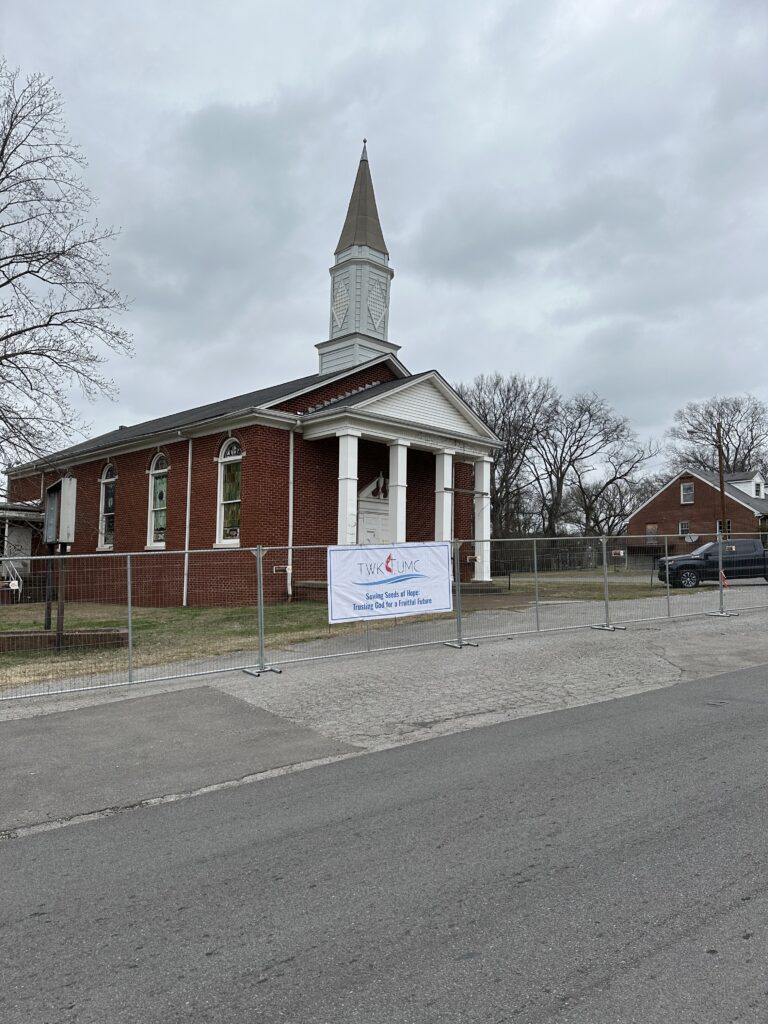By Tyler Sprouse, TWK Communications Specialist

Ernest Newman UMC in the Bordeaux neighborhood of North Nashville is set for demolition in the coming weeks. Leaders from the TWK Conference have erected signs in front of the church that read, “Sowing Seeds of Hope: Trusting God for a Fruitful Future.” Photo by Steve Levin.
In the coming weeks, the buildings associated with Ernest Newman UMC in the Bordeaux neighborhood of North Nashville will be demolished to prevent harm and free the area of hazards. The TWK Conference, local faith leaders, and invested community members are holding fast to the hope that this demolition will clear the way for future vibrant expressions of vital ministry within the neighborhood.
The site on which the church stands has a long history of a Methodist presence. “The United Methodist witness has been in this neighborhood for a long time,” said Rev. Marilyn E. Thornton, pastor of Dixon Memorial UMC and longtime resident of North Nashville. “Before Ernest Newman UMC was located at that address, there was a longstanding white congregation called ‘Bordeaux UMC.’”
Bordeaux UMC was originally called Bordeaux MEC, South and dated back to before the reunification of the northern and southern Methodist Episcopal Churches in 1939. Before ‘39, the Methodist Episcopal Church was split over the issue of slavery and reconstruction (between the years 1846-1939).
Talks began in 1988 to form a new United Methodist Church in the predominantly African American neighborhood of Bordeaux. At a subsequent meeting, Bishop Ernest Newman, the first African American elected bishop in the UMC’s Southeastern Jurisdiction and resident bishop of the Nashville Episcopal Area between 1984-1992, spoke in support of the formation of the new congregation. During this meeting, those present decided to name the church after the bishop.
“It was highly significant to name the congregation after Bishop Newman,” said Rev. Dr. Sheila Peters, the senior pastor of Braden Memorial UMC and one of six original members of Ernest Newman UMC. “This naming was symbolic of our hopes for the congregation. It was a major milestone in the denomination for an African American to be elected bishop after the Central Jurisdiction merged. We wanted to embody that kind of impact as an African American church within the community.”
In the beginning, the Ernest Newman UMC congregation met at Whites Creek Comprehensive High School, until, after nearly a year of using the school’s facilities, the legacy Tennessee Conference Committee on New Church Development procured for the faith community a 80 x 28 foot modular trailer, in which Ernest Newman UMC gathered and worshiped for seven years.
“The trailer was located in Buena Vista,” said Rev. Dr. Peters. “Although it was small, we had enough space to conduct worship services and host activities for our youth.”
Then, in 1996, the congregation moved into the church building located at 2001 Manchester Ave. in the Bordeaux neighborhood of North Nashville, the former home of Bordeaux UMC.
“Around this time, after we moved to Manchester Avenue, we had roughly 30 members,” said Rev. Dr. Peters. “We weren’t a large congregation, but we were active in the community–particularly with our unhoused neighbors.”
In 2008, the congregation celebrated its twentieth anniversary by initiating a capital finance campaign to renovate the church building and create a Christian Life Center. However, due to shifting demographics in the neighborhood, ongoing gentrification, and leadership turnover, the congregation’s growth began to stagnate and decline.
As underscored by the Rev. Sonnye Dixon, the senior pastor of Hobson UMC and member of the founding Ernest Newman UMC Board of Trustees, the Ernest Newman UMC congregation faced significant challenges from its inception.
“From the beginning, the church was under-resourced, which made it hard for them to consistently grow and carve out space in the community,” said Rev. Dixon.
Ernest Newman UMC officially closed in 2017, nearly 30 years after its founding.
Although the church building and parsonage associated with Ernest Newman UMC are being removed, the TWK Conference is far from finished with this site. There is a strong commitment to ensure that the dreams and intentions of Bishop Newman are realized in new ways. Through prayer, discernment, visioning, and discussions within the community, it is our hope that a new expression of faithful ministry will emerge.
“It is my hope that the TWK Conference will continue to seek the guidance of the Holy Spirit as we develop fruitful partnerships with the Bordeaux community to foster hope, healing, reconciliation, advocacy, and justice ministries,” said Rev. Pat Freudenthal, the District Superintendent of the Red River District of the TWK Conference. “My prayer is that we will honor Bishop Newman with something that will bring creative, adaptive responses to the rapidly changing ministry context we face today.”
The leaders of the TWK Conference look forward to holding conversations within the community as this season of prayer and discernment continues.
Please note: Some have asked about salvaging remains from the church building, particularly stained glass. Unfortunately, the stained glass was bowed and fragile; they did not come out in one piece. The windows had previously been flagged for containing asbestos and lead. The Metro Historic Zoning Commission will be onsite soon to further assess the building and its remains.
